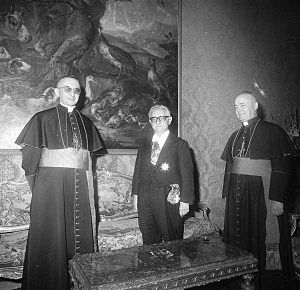Jean-Marie Villot facts for kids
Quick facts for kids His Eminence Jean-Marie Villot |
|
|---|---|
| Secretary of State | |
 |
|
| See | Frascati |
| Appointed | 2 May 1969 |
| Reign ended | 9 March 1979 |
| Predecessor | Amleto Giovanni Cicognani |
| Successor | Agostino Casaroli |
| Other posts |
|
| Orders | |
| Ordination | 19 April 1930 |
| Consecration | 12 October 1954 by Maurice Feltin |
| Created Cardinal | 22 February 1965 |
| Rank | Cardinal-Bishop |
| Personal details | |
| Born | 11 October 1905 Saint-Amant-Tallende, Puy-de-Dôme, France |
| Died | 9 March 1979 (aged 73) Vatican City |
| Nationality | French |
| Previous post |
|
| Motto | auxilium a domino |
| Coat of arms |  |
Jean-Marie Villot (born October 11, 1905 – died March 9, 1979) was an important French leader in the Roman Catholic Church. He was a Cardinal, which is a high-ranking official. He served as the Archbishop of Lyon from 1965 to 1967. Later, he became the Vatican Secretary of State from 1969 to 1979. This role is like being the Pope's top advisor and foreign minister. He was also the Camerlengo of the Holy Roman Church from 1970 to 1979. The Camerlengo manages the Church's affairs when a Pope dies. He became a Cardinal in 1965.
Contents
Early Life and Education
Jean-Marie Villot was born on October 11, 1905. His hometown was Saint-Amant-Tallende in France. He was the only child of Joseph and Marie Villot. He studied to become a priest in different cities in France. These included Riom, Clermont, and Lyon.
After his military service, he joined a religious group called the Marists. However, he left after three months. He then continued his studies in Paris and Rome. In 1934, he earned a special degree in church law. He also received a doctorate in sacred theology.
Becoming a Priest
On April 19, 1930, Jean-Marie Villot became a priest. He was ordained in Paris by Archbishop Alfred-Henri-Marie Baudrillart. For a few years, he worked as a secretary for Bishop Pierre-Marie Gerlier.
Later, he taught at a seminary in Clermont. He also taught at the Catholic University in Lyon. From 1942 to 1950, he was the vice-rector of the university. This means he was a senior leader there. In 1950, he officially joined the Archdiocese of Lyon.
Serving as a Bishop
In 1954, Pope Pius XII chose Villot to be an auxiliary bishop of Paris. This means he helped the main bishop. He became a bishop on October 12, 1954. Cardinal Maurice Feltin led the ceremony.
In 1959, he was named the Coadjutor Archbishop of Lyon. This meant he would take over as Archbishop when the current one retired. He became the Archbishop of Lyon on January 17, 1965.
During the Second Vatican Council, he played an important role. This was a major meeting of Catholic bishops from around the world. His work there impressed Pope Paul VI.
Becoming a Cardinal
| Styles of Jean-Marie Villot |
|
|---|---|
 |
|
| Reference style | His Eminence |
| Spoken style | Your Eminence |
| Informal style | Cardinal |
| See | Lyon |
On February 22, 1965, Pope Paul VI made him a Cardinal. This is a very high position in the Catholic Church.
In 1967, he became the head of the Congregation for the Clergy. This department helps manage priests around the world. Two years later, in 1969, he was chosen for an even bigger job. He became the Cardinal Secretary of State. This role is like being the Pope's chief of staff and foreign minister. Pope Paul VI wanted to include more non-Italians in top Vatican jobs.
Cardinal Villot also became the head of other important Vatican offices. He led the group that managed Vatican City State. He also oversaw the Church's property and money.
On October 16, 1970, he was named Camerlengo of the Holy Roman Church. He was the first non-Italian in this role in 500 years. The Camerlengo is in charge of the Church when a Pope dies. He helps prepare for the election of a new Pope. In 1971, he also became the president of a new council called Cor Unum. This group focused on charity and helping others. He left this role in 1978.

In 1974, Pope Paul VI made him a Cardinal Bishop of Frascati. Cardinal Villot was present when Pope Paul VI died in August 1978.
When Pope John Paul I was elected, he kept Cardinal Villot as Secretary of State. After John Paul I's short time as Pope, Pope John Paul II was elected. He also kept Villot in his important roles for a short time. Cardinal Villot had suggested that the new Pope, who was not Italian, might want an Italian Secretary of State. Villot was replaced as Secretary of State in July 1979, a few months after his death.
Cardinal Villot played a key part in both papal elections in 1978. As the senior cardinal bishop, he presided over these meetings. These meetings are called conclaves. As Camerlengo, he managed the Church's daily operations during the times between Popes.
Death
Cardinal Jean-Marie Villot died on March 9, 1979. He was 73 years old. He passed away from pneumonia in his apartment in Vatican City. Pope John Paul II held his funeral Mass in St. Peter's Basilica. Cardinal Villot was buried in the crypt of Ss. Trinità al Monte Pincio.
See also
 In Spanish: Jean-Marie Villot para niños
In Spanish: Jean-Marie Villot para niños


